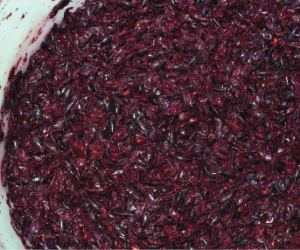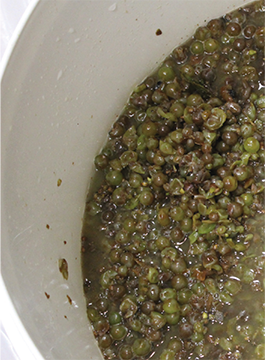Making wine away from winemaking regions is becoming more popular. As these pros will tell you, urban winemaking comes with unique benefits and challenges.
Jared Brandt and his wife, Tracey, are the owners and winemakers of Donkey and Goat in Berkeley, California. The Brandts craft their natural wines from Rhône varietals, Chardonnay and Pinot Noir grown in the Anderson Valley, Mendocino Ridge and El Dorado appellation in the Sierra Foothills.
We lease our vineyards — in some cases managing them directly and in others working with a vineyard manager. The biggest challenge of being an urban winemaker is staying on top of the vineyard. Ours are all a two-hour drive (in opposite directions). How far we are willing to travel for frequent visits dictates where our vineyards are. We check agricultural weather stations daily — these stations have additional data useful for tracking the maturing of grapes.
The biggest issue we run into with off-site vineyards is keeping the grapes cool. We pick early in the morning and have the grapes to the winery by noon because I don’t want my grapes to get hot after being picked. We benefit by having friends and customers close by to help with harvest and other activities.
For home winemakers in urban areas, I think getting grapes at the maturity level desired would be the biggest challenge. You need to work with someone you trust and who will deliver what you are interested in. If you can find that scenario, it allows you to live where you desire and still be involved in every step of the winemaking process. We were able to start our winery and stay in an urban area, which is what we wanted to do for personal reasons. I don’t think the location of the winery is that important when it comes to quality. You can make great wine in Napa or in Berkeley.
My advice for home winemakers is to have fun and wait before you intervene. Sometimes issues just work themselves out with time.
Conor McCormack, head winemaker at Brooklyn Winery in New York. Born in Limerick, Ireland, and raised in Northern California, Conor got into winemaking after graduating college.
I was very concerned about the ability to make great wine when I first came to Brooklyn from California, but we have the logistics down and the grapes show up in perfect condition. For the most part, I use the same vineyards every year and work directly with growers in California and New York. Starting with high-quality fruit hand-picked at the optimal ripeness, and refrigerated transport, the grapes arrive just as clean as if it was a 10-minute tractor ride.
All of our grapes are under contract, mostly single-year terms, and I work with the growers to ensure the best possible results for the styles I am producing. When acquiring a new vineyard, I have a checklist of things I am looking for, but ultimately it is the history of the vineyard and the approach of the grower that are most important. Quality parameters are also stated very clearly in our contracts. For our New York grapes, I get out and see the vineyards pretty often, especially around harvest. Otherwise I rely on a lot of updates by phone.
The biggest benefit to urban winemaking is access to the marketplace. The public has easy access to visit the winery, see the operation, and taste wines without having to travel out to wine country. The biggest challenges are space and logistics. We are operating at full capacity in our facility so I need to be creative in maximizing space without compromising quality. Offloading a 52-foot tractor-trailer on the streets of Brooklyn during rush hour can get dicey too.
I imagine the challenge of restricted space is the biggest hurdle for home winemakers too. I used to keep 5-gallon (19-L) carboys of wine in every closet of my apartment in Oakland and do any “wet” work in the bathtub when I first got into the business. My advice is don’t let space deter you. There is always a way. Another idea to save space (and cash) is finding other home winemakers in your area and sharing the more cumbersome equipment like presses and de-stemmers.
David Lecomte is Head Winemaker for City Winery, Manhattan’s first fully operational winery (and with a second location in Chicago).
The biggest challenge for us is being far away from the vineyard where we have to rely on other people to make the proper decisions regarding the vineyard practice. We purchase varietals from California, Oregon, Washington, New York and overseas. I travel to the West Coast 3-4 times a year, but we also hire vineyard liaisons during the harvest season. We know exactly what we are getting because we have people overseeing the crops and deciding the harvest date.
The biggest challenge for home winemakers is relying on the person sending them the crop. If you don’t know when the grapes were picked or you have no clue how they were shipped, that’s got to be a challenge. The best way is with a middleman working between the growers and the buyer.
Space is another issue. We don’t have an empty warehouse to use, but to be frank; you’re always running out of space no matter where you are. We keg about half of our wine, which helps with that.
Of course, being a winery that also features a restaurant and entertainment also has significant advantages. We have direct contact with the final customer, which means even if the production cost is slightly higher than for others making the same wine from the same harvest, we have the benefit of getting 100 percent of the sale in our pocket. That interaction also gives us an understanding of what people are looking for. We’re getting feedback from the customer every day.
The location of a winery does not dictate the quality of wine it makes. We are a commercial winery in a strange location, but the quality of the crop and how fast we can chill the grapes is more important than how many days the grapes take to ship. Plus, the equipment I’m using is very similar to that of any high-end winery.







